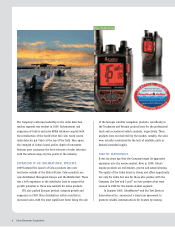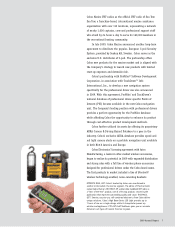Cobra 2009 Annual Report Download - page 13
Download and view the complete annual report
Please find page 13 of the 2009 Cobra annual report below. You can navigate through the pages in the report by either clicking on the pages listed below, or by using the keyword search tool below to find specific information within the annual report.
2009 Annual Report 11
Quarter Ended
March 31 June 30 September 30 December 31
2009 2008 2009 2008 2009 2008 2009 2008
Net sales $ 19,085 $ 28,858 $ 25,971 $ 34,318 $ 27,405 $ 33,242 $ 32,768 $ 28,327
Gross profit 5,062 8,916 6,232 11,440 6,628 9,704 8,454 8,109
Net (loss) earnings (1,616 ) 81 (9,902 ) 1,710 (509 ) 142 1,755 (20,772 )
Net (loss) earnings per share (a)
Basic $ (0.25 ) $ 0.01 $ (1.53 ) $ 0.26 $ (0.08 ) $ 0.02 $ 0.27 $ (3.21 )
Diluted (0.25 ) 0.01 (1.53 ) 0.26 (0.08 ) 0.02 0.27 (3.21 )
(a) The sum of the quarterly net earnings (loss) per share amounts may not equal the annual amount because net earnings (loss) per share are calculated
independently for each quarter.
EBITDA
(In thousands)
The following table shows the reconciliation of net income to EBITDA and adjusted EBITDA:
Year Ended December 31,
2009 2008
Net loss $ (10,272 ) $ (18,839 )
Depreciation and amortization 3,883 5,296
Interest expense 928 997
Income tax provision 6,762 598
EBITDA 1,301 (11,948 )
Stock option expense 229 253
CSV loss (gain) (743 ) 1,558
Non-controlling interest 2 11
Deferred revenue, database 755 426
Impairment – 20,350
Other non-cash items (435 ) (300 )
Adjusted EBITDA $ 1,109 $ 10,350
EBITDA represents earnings before interest, taxes, depreciation and amortization. Adjusted EBITDA represents EBITDA plus the
applicable adjustments required to agree with the EBITDA measurement for compliance with the financial covenants of the Company’s
lenders. The Company believes EBITDA is a useful performance indicator and is frequently used by management, securities analysts,
and investors to judge operating performance between time periods and among other companies. The Company uses adjusted EBITDA
to assess operating performance and ensure compliance with financial covenants.
EBITDA and adjusted EBITDA are Non-GAAP performance indicators that should be used in conjunction with Generally Accepted
Accounting Principles (“GAAP”) performance measurements such as net sales, operating profit, and net income to evaluate the
Company’s operating performance. EBITDA and adjusted EBITDA are not alternatives to net income or cash flow from operations
determined in accordance with GAAP. Furthermore, EBITDA and adjusted EBITDA may not be comparable to the calculation of similar
titled measures reported by companies.
Quarterly Financial Data (Unaudited)
(In thousands, except per share amounts)

















